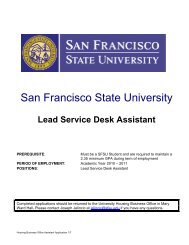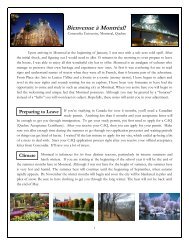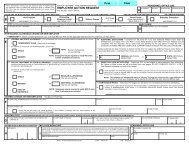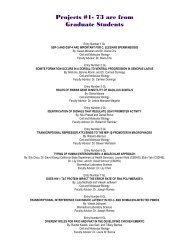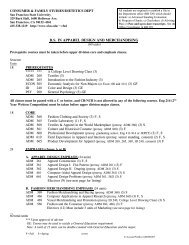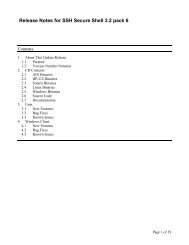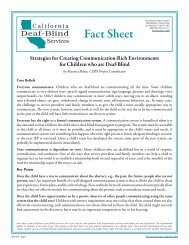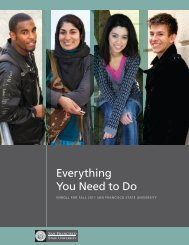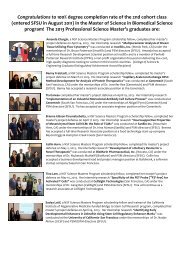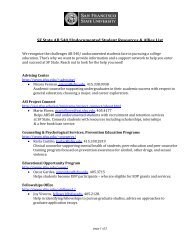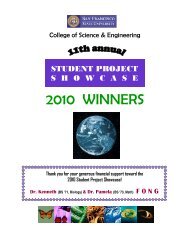reSources Spring 2008 (Vol. 13, No. 2) - San Francisco State ...
reSources Spring 2008 (Vol. 13, No. 2) - San Francisco State ...
reSources Spring 2008 (Vol. 13, No. 2) - San Francisco State ...
Create successful ePaper yourself
Turn your PDF publications into a flip-book with our unique Google optimized e-Paper software.
http://www.sfsu.edu/~cadbs/News.html<br />
California<br />
Deaf-Blind<br />
Services<br />
Rethinking Circle Time<br />
By Maurice Belote, CDBS Project Coordinator<br />
What is it about circle time with children who<br />
are deaf-blind that causes such consternation<br />
among educators? At its best, circle time<br />
can be a positive tool for building social awareness,<br />
communication skills, and a sense of connectedness<br />
among peers. But it can also sap energy from puzzled team<br />
members who struggle to find ways to include children<br />
who are deaf-blind in this traditional activity that occurs<br />
in most classrooms at some point during the school day.<br />
minutes with their classmates and teachers, everyone sits<br />
in a circle and says good morning to one another. But<br />
the “good mornings” were all said when the children<br />
first arrived to school. Think of that awkward situation<br />
many of us have experienced when someone says good<br />
morning to you at work for the second time in one day.<br />
In the culture of greetings, we are allowed only one<br />
“good morning” for a particular person each day. There<br />
is an expectation that each subsequent interaction will<br />
include a fresh choice from the menu of greeting options.<br />
Morning circle time seems to be a fairly typical part of most<br />
preschools and is an equally pervasive activity in most<br />
special day classes—regardless of the age of the students.<br />
In general education, the concept of morning circle still<br />
often exists, although it takes other forms as students age.<br />
In elementary school, it might be a time to talk about the<br />
schedule for the day, and hear about upcoming classroom<br />
events, relevant local and world news, sharing, etc. The<br />
instructional day of many middle and high schools starts<br />
with first-period homerooms, during which students<br />
receive announcements about extracurricular events<br />
such as athletic games, dances, fundraisers, etc. This<br />
is usually a motivating time for high school students<br />
because this is the age when many students become<br />
more interested in elective courses and extracurricular<br />
activities than in the more traditional, academic subjects.<br />
Most circle time activities are primarily built around<br />
visual and auditory activities (e.g., verbal greetings,<br />
the singing of songs, and the use of wall charts). Many<br />
components of a traditional circle time, therefore, can be<br />
downright confusing and/or inaccessible to a child with<br />
hearing and vision loss. It shouldn’t seem surprising that<br />
many children who are deaf-blind “fail” circle time—by<br />
refusing to sit quietly, by engaging in behaviors that<br />
will likely result in being removed from the activity,<br />
or simply by refusing to go to the circle area at all.<br />
Children with typically developing language might<br />
understand that this is like a game. We say good morning<br />
at circle because we look at each other and enjoy the<br />
verbal and non-verbal responses our greetings elicit.<br />
Another morning circle activity that some children will<br />
rightly perceive as a game is when we ask children to tell<br />
us our name. Even more puzzling to children who are<br />
deaf-blind might be when we ask them to tell us their<br />
own names. Can you imagine what a child who is deafblind<br />
might be thinking when a familiar adult asks them<br />
their name? I imagine they must be thinking, “Well, if<br />
you don’t know my name by now, then I just give up”.<br />
We always want to consider the age-appropriateness<br />
of morning circle activities and make necessary<br />
modifications/adaptations to the activities so that they<br />
are consistent with what other children of the same age<br />
need and want. If you’re not sure about what children<br />
of a certain age are interested in, just ask some nondisabled<br />
peers. They will gladly share their lists of<br />
favorite singers, movies, radio stations, TV shows, etc.<br />
For example, while it may be traditional to sing a good<br />
morning song, what a delight it might be for a student<br />
with some usable hearing to recognize music that<br />
is played at a school assembly or dance because that<br />
student has heard the songs many times during morning<br />
group. If the student is an occasional hearing aid or<br />
cochlear implant user, this might be the time the student<br />
willingly chooses to use his or her assistive technology.<br />
Much of what constitutes traditional circle time is basically<br />
irrelevant to children who are deaf-blind. For example,<br />
consider a preschool classroom in which circle time<br />
occurs after the children have come in from the bus, put<br />
away their backpacks, used the bathroom, had breakfast,<br />
and brushed their teeth. After having spent many (continued on page 4)<br />
California Deaf–Blind Services <strong>reSources</strong> Winter 2009 <strong>Vol</strong>. 14, Number 1 page 3



